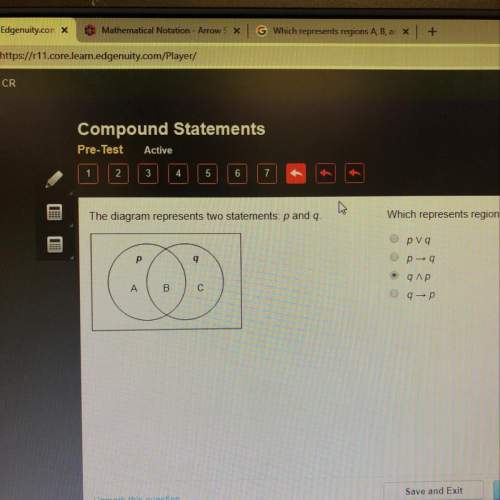
Mathematics, 08.03.2020 04:10 MayFlowers
How do the expressions 4(3+x) and (3+3+3+3) +(x+x+x+x) compare to one another?

Answers: 1
Another question on Mathematics

Mathematics, 21.06.2019 19:10
Girardo is using the model below to solve the equation . girardo uses the following steps: step 1 add 4 negative x-tiles to both sides step 2 add 1 negative unit tile to both sides step 3 the solution is which step could be adjusted so that gerardo's final step results in a positive x-value? in step 1, he should have added 4 positive x-tiles to both sides. in step 1, he should have added 3 negative x-tiles to both sides. in step 2, he should have added 4 negative unit tiles to both sides. in step 2, he should have added 1 positive unit tile to both sides.
Answers: 2

Mathematics, 21.06.2019 23:30
If you measured the width of a window in inches and then in feet with measurement would you have the greater number of units
Answers: 3

Mathematics, 22.06.2019 02:00
The plant were you work has a cylindrical oil tank that is 2.5 feet across on the inside and 10 feet high. the depth of the oil in the tank is 2 feet. about how many gallons of oil are in the tank?
Answers: 2

Mathematics, 22.06.2019 03:00
In this problem, we explore the effect on the standard deviation of multiplying each data value in a data set by the same constant. consider the data set 14, 6, 8, 15, 15. (a) use the defining formula, the computation formula, or a calculator to compute s. (round your answer to one decimal place.) s = 4.28 (b) multiply each data value by 3 to obtain the new data set 42, 18, 24, 45, 45. compute s. (round your answer to one decimal place.) s = 12.83 (c) compare the results of parts (a) and (b). in general, how does the standard deviation change if each data value is multiplied by a constant c? multiplying each data value by the same constant c results in the standard deviation remaining the same. multiplying each data value by the same constant c results in the standard deviation being |c| times as large. multiplying each data value by the same constant c results in the standard deviation increasing by c units. multiplying each data value by the same constant c results in the standard deviation being |c| times smaller. (d) you recorded the weekly distances you bicycled in miles and computed the standard deviation to be s = 3.8 miles. your friend wants to know the standard deviation in kilometers. do you need to redo all the calculations? yes no given 1 mile ≠1.6 kilometers, what is the standard deviation in kilometers? (enter your answer to two decimal places.)
Answers: 1
You know the right answer?
How do the expressions 4(3+x) and (3+3+3+3) +(x+x+x+x) compare to one another?...
Questions

Mathematics, 21.07.2019 20:00

Biology, 21.07.2019 20:00

Mathematics, 21.07.2019 20:00

Mathematics, 21.07.2019 20:00

Mathematics, 21.07.2019 20:00

Mathematics, 21.07.2019 20:00

Social Studies, 21.07.2019 20:00

Mathematics, 21.07.2019 20:00


Mathematics, 21.07.2019 20:00



Mathematics, 21.07.2019 20:00




English, 21.07.2019 20:00


Mathematics, 21.07.2019 20:00

Mathematics, 21.07.2019 20:00




